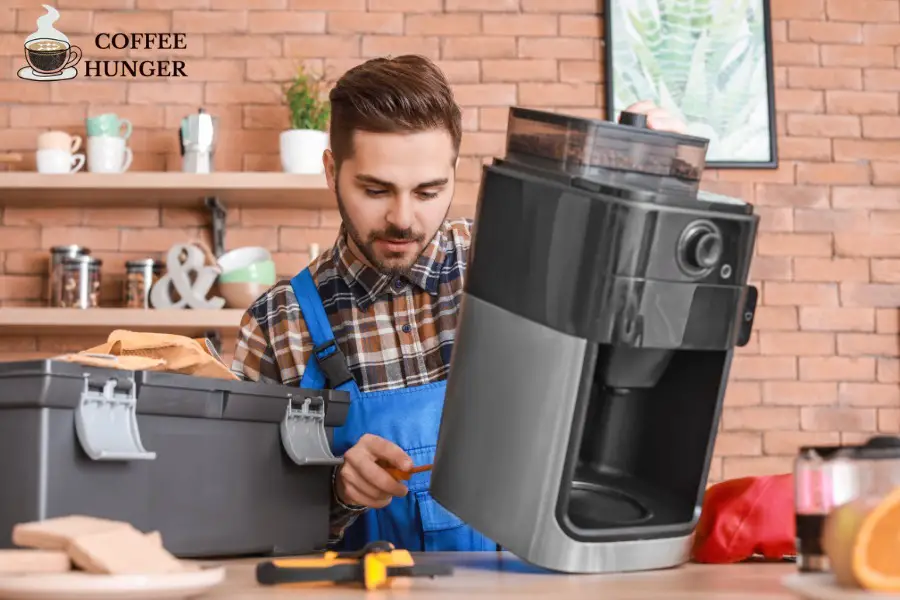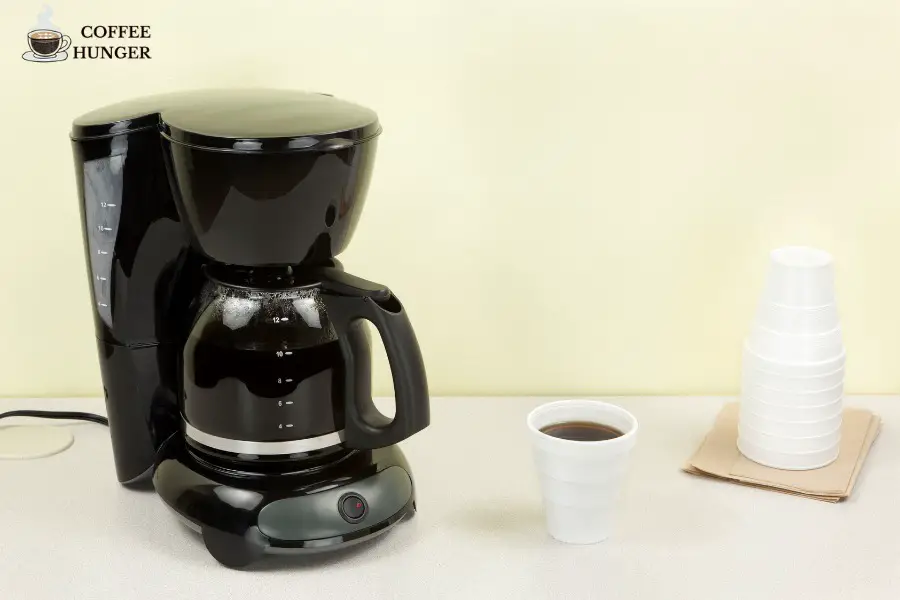Do you know how to clean a coffee maker without vinegar? Coffee maker, also known as a coffee machine or coffee brewer, is a household appliance used to brew coffee. It typically consists of a water reservoir, a heating element, a filter holder, and a carafe to hold the brewed coffee. There are many different coffee makers, including drip coffee makers, single-serve brewers, and espresso machines.
It’s essential to clean a coffee maker regularly because it can accumulate a buildup of mineral deposits and oils, which can affect the taste of your coffee and the performance of your machine. Additionally, bacteria and mold can grow in a coffee maker’s warm, moist environment, which can harm your health. Cleaning your coffee maker on a regular basis can prevent these issues and ensure that your coffee tastes fresh every time you brew a cup.
While many people use vinegar as a cleaning solution for their coffee makers, other options can be just as effective.
This article will explore different methods for cleaning a coffee maker without using vinegar, including baking soda, lemon juice, and specialized cleaning products. Whether you are looking for a natural cleaning solution or want to avoid the strong smell of vinegar, this article will provide the information you need to keep your coffee maker running smoothly.
Preparation: How to clean coffee maker without Vinegar?
What materials do you need to prepare:
The materials you will need to prepare for cleaning a coffee maker without vinegar will depend on the method you choose to use. Here are a few common materials that may be required for different cleaning methods:
- Baking soda and water: Mixing baking soda and water creates a paste that can scrub away mineral deposits and coffee oils.
- Specialized cleaning products: There are specialized cleaning products available that are designed specifically for cleaning coffee makers. These products may be in the form of tablets, powders, or liquids, and they will have the instructions on the container.
- Dishwashing liquid: Dishwashing liquid can clean the insides of your coffee maker, including the carafe and the heating element.
In addition to these specific materials, you will also need a few general items for cleaning your coffee maker, such as:
- A brush or sponge for scrubbing
- A container for mixing cleaning solutions
- A clean, damp cloth for wiping down the machine
- A carafe for rinsing and cleaning the carafe
It’s also important to check the manufacturer’s instructions for your specific coffee maker to ensure that you use the appropriate cleaning methods and materials. Some coffee makers have particular instructions for cleaning and maintaining the machine, and using the wrong materials or methods could void the warranty or even damage the engine.
Step-by-Step Guide to Clean a Coffee Maker without Vinegar
Here is a step-by-step guide for cleaning a coffee maker without vinegar, including three different methods:
Method 1: Boiling Water
- Get the water out of the coffee maker and unplug it.
- Fill the reservoir with fresh, clean water and bring it to a boil on the stove or in the microwave.
- Carefully pour the boiling water into the coffee maker’s water reservoir.
- Turn the coffee maker on and run a complete brew cycle.
- Once the brew cycle is complete, could you turn off the coffee maker and unplug it?
- Allow the coffee maker to cool for a few minutes before emptying the carafe and the reservoir.
- Rinse the carafe and the reservoir with clean water, then dry them thoroughly.
- Repeat the process if necessary.
Method 2: Baking Soda Unhook the coffee maker and drain the water tank.
- Disconnect the coffee maker and evacuate the water tank.
- Mix one tablespoon of baking soda with 1 cup of warm water in a small bowl.
- Use a brush or sponge to apply the baking soda mixture to the inside of the coffee maker’s water reservoir, carafe, and other areas that need cleaning.
- Scrub the coffee maker with the mixture, paying particular attention to any mineral buildup or stains.
- Once you’ve finished scrubbing, rinse the coffee maker thoroughly with clean water.
- Dry the coffee maker and its parts with a clean cloth
- Repeat the process if necessary.
Method 3: Dishwashing Liquid
- Unplug the coffee maker and empty the water reservoir.
- In a small bowl, mix a small amount of dishwashing liquid with warm water to create a cleaning solution.
- Use a brush or sponge to apply the cleaning solution to the inside of the coffee maker’s water reservoir, carafe, and any other areas that need cleaning.
- Scrub the coffee maker with the solution, paying particular attention to any mineral buildup or stains.
- Once you’ve finished scrubbing, rinse the coffee maker thoroughly with clean water.
- Dry the coffee maker and its parts with a clean cloth.
It’s worth noting that, no matter which method you choose, it’s essential to rinse the coffee maker thoroughly with clean water after cleaning to remove any residue and dry the machine and its parts thoroughly before using them again.
Cleaning Tips and Tricks
Here are a few tips and tricks that can help you clean your coffee maker more efficiently and effectively:
- Clean your coffee maker regularly: The longer you wait between cleanings, the harder it will be to remove mineral buildup and stains. A good rule of thumb is to clean your coffee maker every three months or more frequently if you live in an area with hard water.
- Use the proper cleaning method for your coffee maker: Different coffee makers have different cleaning requirements, so check the manufacturer’s instructions for your specific machine. Some coffee makers have specialized cleaning cycles that you can use or may require specific cleaning products.
- Use the appropriate cleaning tools: A soft-bristled brush or sponge can effectively scrub off mineral buildup and stains, and one damp cloth can be used to wipe down the machine and its parts.
- Use the right cleaning solution: Be careful not to use too much cleaning solution, as this can leave residue and affect the taste of your coffee. Follow the manufacturer’s instructions or the recipe you are using.
- Pay attention to hard-to-reach areas: Be sure to clean all the parts of the coffee maker, including the water reservoir, carafe, and any other hard-to-reach areas. These areas are often where mineral buildup and stains are most likely to occur.
- Descale your coffee maker: If you live in an area with hard water, you may need to use it more frequently. Descaling is the process of removing mineral buildup from your coffee maker and can help to improve the taste of your coffee and the performance of your machine.
Once done with cleaning, run a cycle of plain water before using the coffee maker to brew coffee. By following these tips and tricks, you can help to ensure that your coffee maker is running at its best and that your coffee tastes fresh every time you brew a cup.
Advantages and Disadvantages of Cleaning a Coffee Maker without Vinegar
Here are some advantages and disadvantages of each method for cleaning a coffee maker without vinegar:
Method 1: Boiling Water
Advantages:
- Simple and easy to do.
- It does not require any specialized cleaning products.
- It can help to remove mineral buildup and stains effectively.
Disadvantages:
- It can be time-consuming, as you need to wait for the water to boil.
- Care should be taken when handling boiling water as it can burn you.
- Not suitable for cleaning the carafe or other parts of the coffee maker.
Method 2: Baking Soda
Advantages:
- It can help to remove mineral buildup and stains effectively.
- Simple and easy to do.
- Inexpensive and readily available.
Disadvantages:
- It can be messy to clean up.
- It may leave a baking soda residue if not rinsed thoroughly.
- Not suitable for cleaning aluminum parts.
Method 3: Dishwashing Liquid
Advantages:
- It can help to remove mineral buildup and stains effectively.
- Simple and easy to do.
- Dishwashing liquid is readily available.
Disadvantages:
- It may leave a soap residue if not rinsed thoroughly.
- Not suitable for cleaning aluminum parts.
Conclusion
Cleaning a coffee maker is an important task that helps ensure that your coffee tastes fresh and that your machine runs at its best. While many people use vinegar as a cleaning solution for their coffee makers, other options can be just as effective.
There are several different methods to clean a coffee maker without using vinegar, such as boiling water, baking soda, dishwashing liquid, citrus juice, club soda, CLR, or Lime-A-Way. Each method has advantages and disadvantages, such as being simple and easy to do or being more expensive than other cleaning methods.
It’s essential to clean a coffee maker regularly and to use the proper cleaning method for your coffee maker. Some coffee makers have specialized cleaning cycles that you can use or that may require specific cleaning products. Always pay attention to hard-to-reach areas, and be careful not to use too much cleaning solution, as this can leave residue and affect the taste of your coffee.
Rinsing the coffee maker thoroughly with clean water after cleaning and drying the machine and its parts thoroughly before using them again are the key steps to follow in the cleaning process. Also, check the manufacturer’s instructions for your specific coffee maker to ensure that you use the appropriate cleaning methods and materials.
FAQs
Q1. What can I use to descale my Keurig?
AnThere are several methods you can use to descale your Keurig, including using a descaling solution specifically designed for Keurig machines, a mixture of water and white vinegar, or a mixture of water and citric acid. Each method has its advantages and disadvantages, so check the manufacturer’s instructions for your specific machine before proceeding.
Q2. What is the difference between cleaning vinegar and regular vinegar?
Cleaning vinegar is a type of vinegar formulated explicitly for cleaning purposes. It is typically made from a blend of different vinegar and is more acidic than regular vinegar. This increased acidity makes it more effective at breaking down mineral buildup and stains.
Q3. How often should you clean your coffee maker?
A good rule of thumb is to clean your coffee maker every three months or more frequently if you live in an area with hard water. Additionally, you should clean your coffee maker immediately if you notice any mold or bacteria buildup.
Q4. Does vinegar damage the coffee maker?
Vinegar is generally considered safe for cleaning coffee makers, but it’s always important to check the manufacturer’s instructions for your specific machine. Some coffee makers have parts sensitive to acid, and vinegar may damage them. Additionally, if not rinsed thoroughly, vinegar can leave a residue affecting your coffee’s taste.
Q5. Can I descale my Keurig with just water?
It’s possible to descale your Keurig using just water. Still, it may not be as effective as using a descaling solution specifically designed for Keurig machines or using a mixture of water and white vinegar. Additionally, the process of descaling with just water may take longer and require multiple cycles of running water through the machine. Check the manufacturer’s instructions for your specific device before proceeding.
Also Read:
How much caffeine is in Vietnamese coffee?
When can I drink Coffee after Tooth Extraction?


